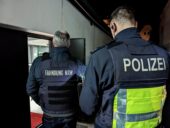A joint Franco-German police force will be deployed to sporting events, protests and against “migration flows”. Another unit undermines Germany’s principle of separation between the police and the military.
Germany and France want to strengthen their cooperation against “migration flows”. To this end, the two countries had set up a “Joint French-German Service Unit” (“Gemeinsame deutsch-französische Diensteinheit”, GDFD) in 2021. At the joint Council of Ministers on Sunday, German Interior Minister Nancy Faeser and her counterpart Gérald Darmanin converted this initially provisional structure with an administrative agreement into a permanent organisational unit.
The German Federal Police and the French border police are both involved. To “combat irregular migration”, the GDFD is to carry out joint patrols at the border of the two countries. So far, operations have only taken place in the Eurometropolis of Kehl/Strasbourg, according to the German Ministry of the Interior at the request of “nd”. Joint “large-scale controls to detect the smuggling in containers” and the operation on the occasion of the Christmas market in Strasbourg are also mentioned. The unit is also supposed to support the local services in special situations.
As early as 2019, the two governments had agreed in the “Treaty of Aix-la-Chapelle” to establish a “French-German task force” (“Unité opérationnelle franco-allemande”, UOFA) of the Federal Police and the Gendarmerie; the then Interior Ministers Horst Seehofer and Christophe Castaner finally founded it in autumn 2019 as the unit “Daniel Nivel”. It is named after a French gendarme who was seriously injured by German hooligans during the 1998 World Cup in France. The incident caused numerous new police and judicial cooperations among EU states.
Unlike the GDFD, the UOFA is an “occasional unit” that is to be deployed at major political or sporting events. In 2020, it should consist of 15 members each from the Federal Police and the Gendarmerie. In France, they come from motorbike squadrons, search brigades or task forces. On the German side, it should include experts “for the processing of migration and document fraud offences”.
The French-German units are also sent to support the riot police or customs in the host country. For example, the UOFA carried out border controls during an international demonstration against the murder of three Kurdish politicians in Paris on 7 January. According to the Federal Police, 22 people were banned from leaving Germany towards France. The unit also participates in German “helicopter jump searches”. In this case, the officers are dropped off at various border sections in a flash over the course of a day.
Joint police operations or patrols in the border area are not uncommon in the EU, but with fixed organisational structures such as the GDFD or UOFA they are unique. This allows restrictions in the area of sovereign powers or data protection to be circumvented. The Federal Police, for example, is not allowed to access French police databases, but can ask colleagues in the UOFA to do so through informal channels. The Gendarmerie describes this as “a real added value”.
The cooperation is also problematic from the point of view of the separation principle between the police and the military that applies in Germany. Gendarmerie units undergo basic training with the military and therefore have combatant status.
According to the German Ministry of the Interior, the UOFA is also to carry out “stabilisation operations” outside the EU. To this end, the unit has already attended trainings on the basics of “police deployment abroad” and different “police tactics”. Missions to “francophone third countries” are also planned. The phrase could refer to former French colonies. According to the German Ministry of the Interior, there are no concrete plans for such missions at the moment.
Published in German in „nd“.
Police and gendarmerie at a joint checkpoint (Image: French Gendarmerie).





Leave a Reply